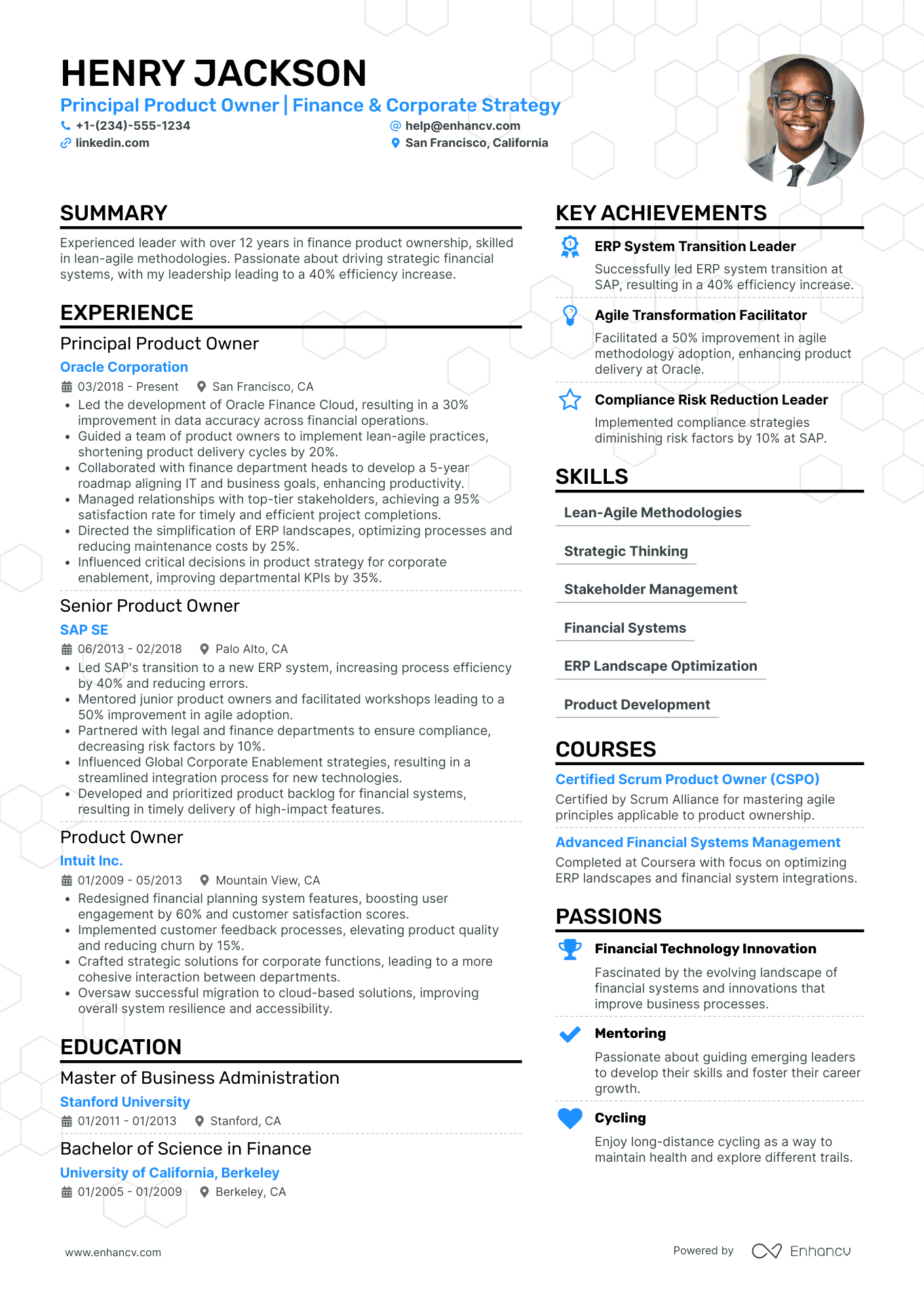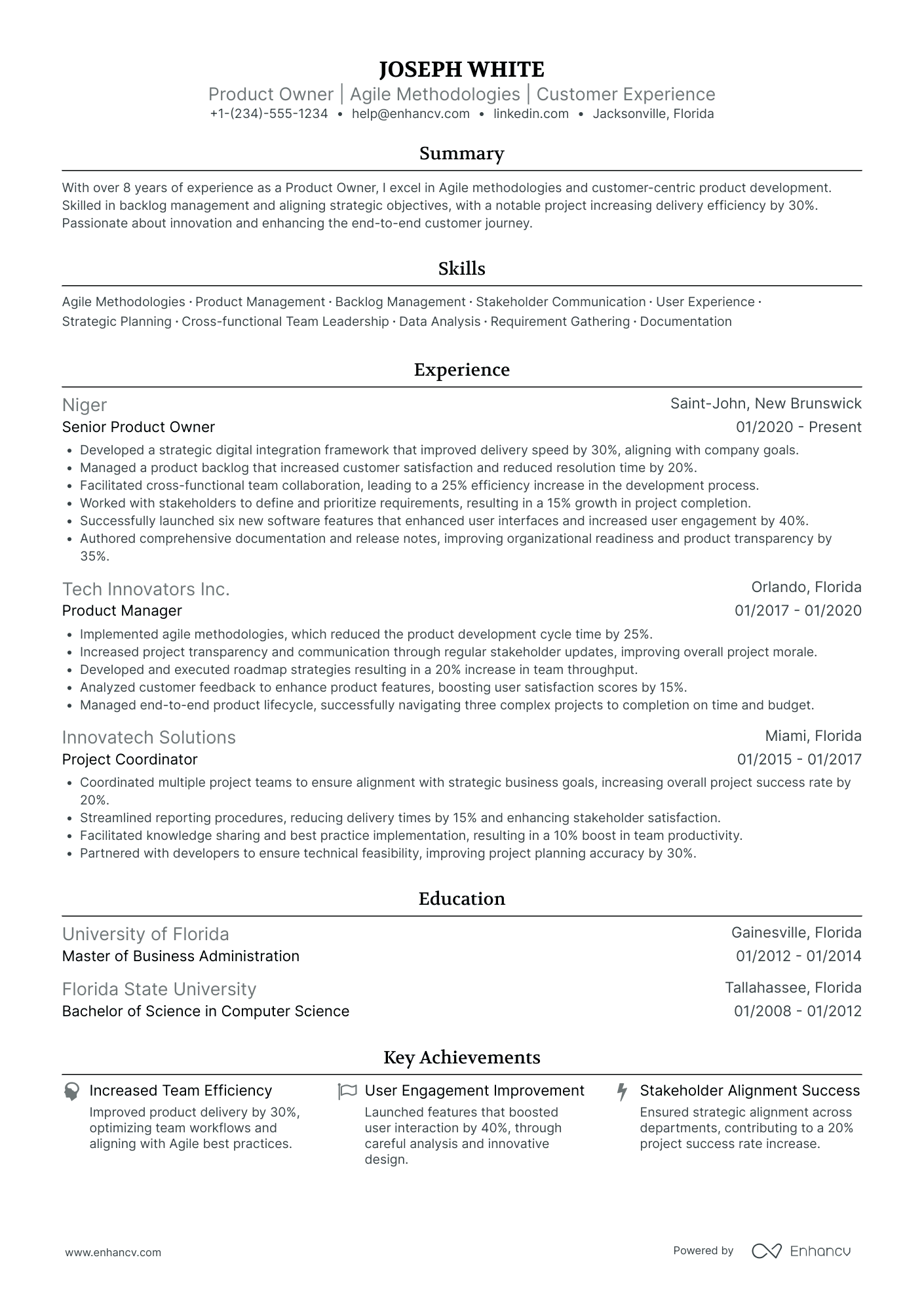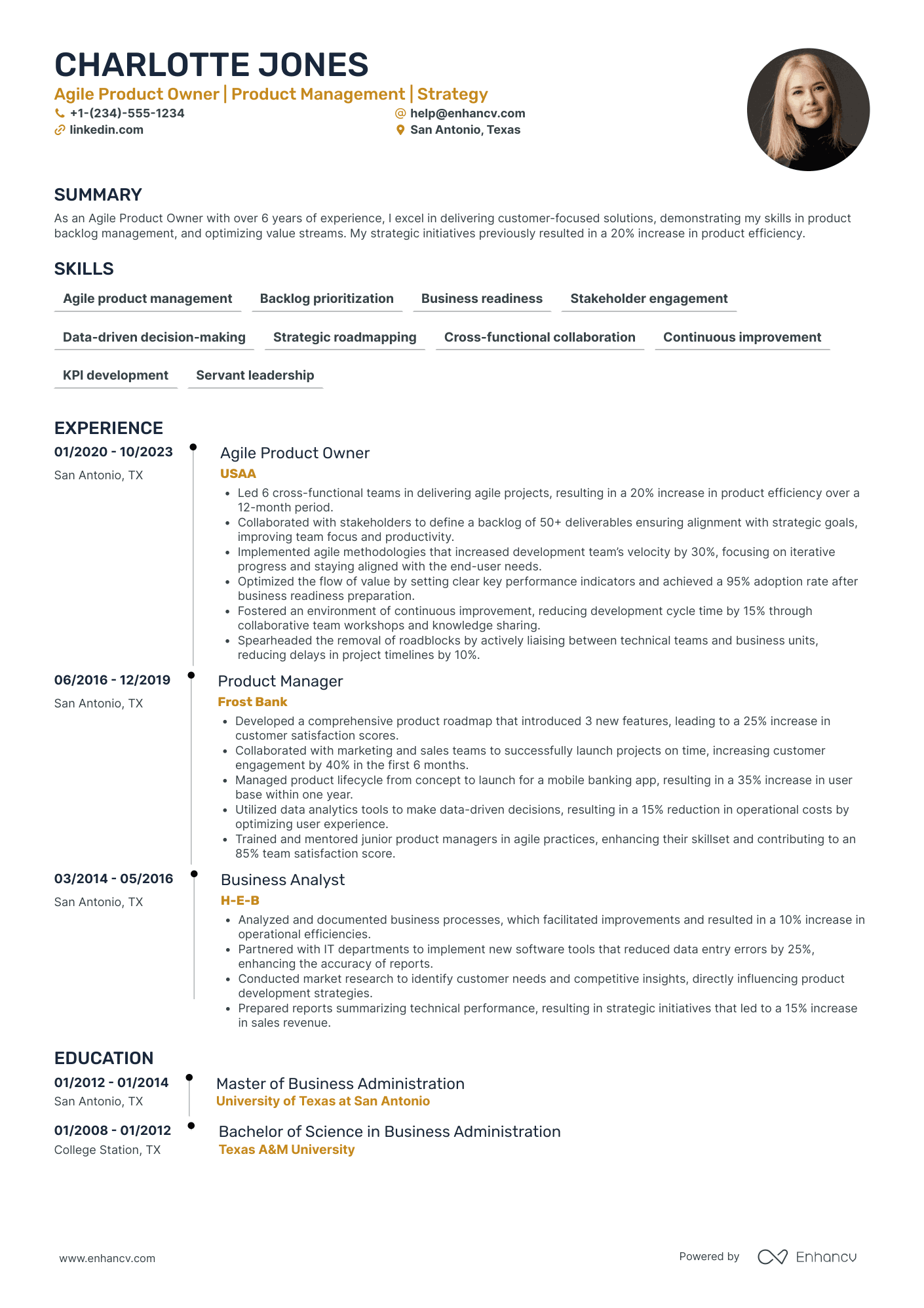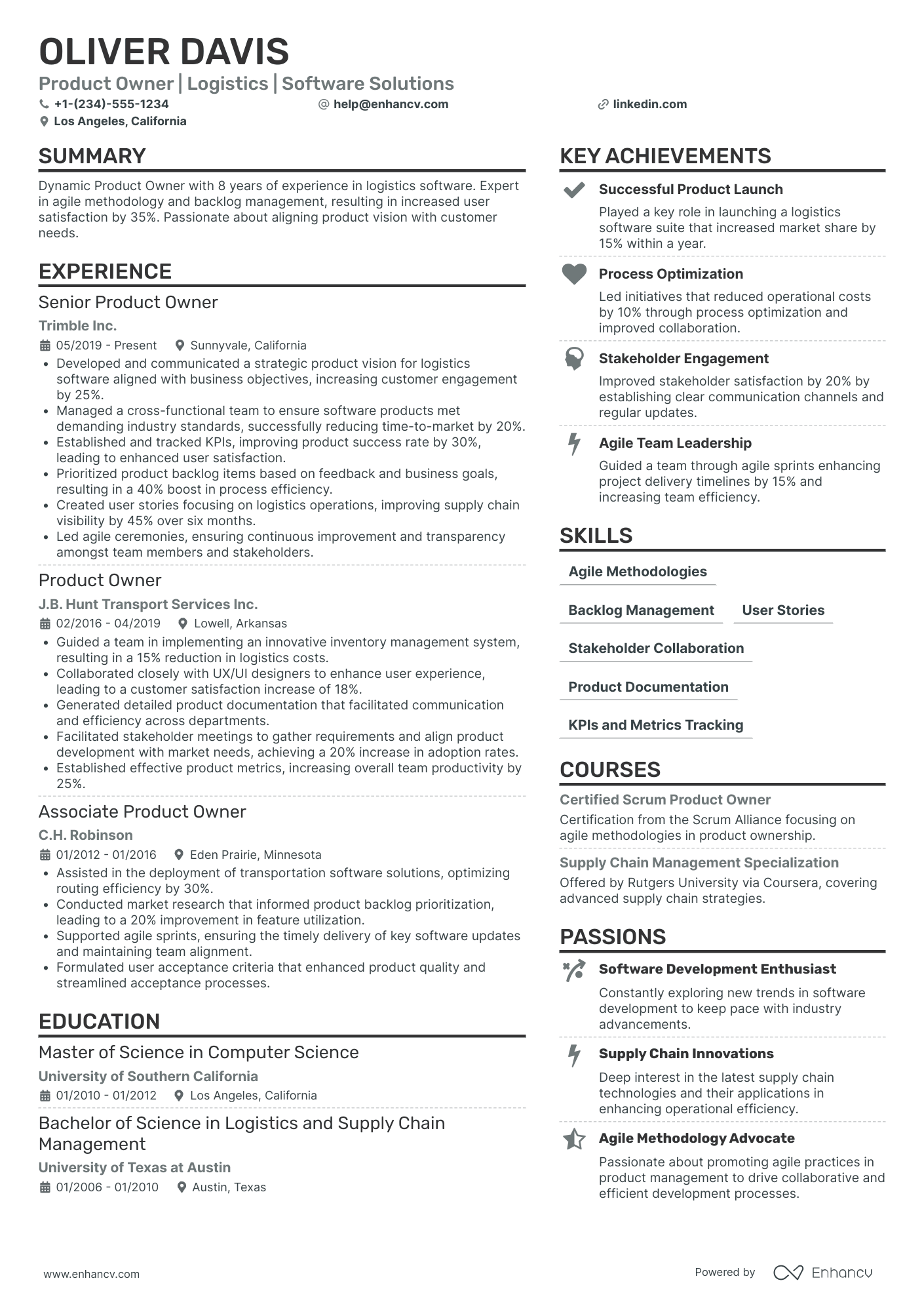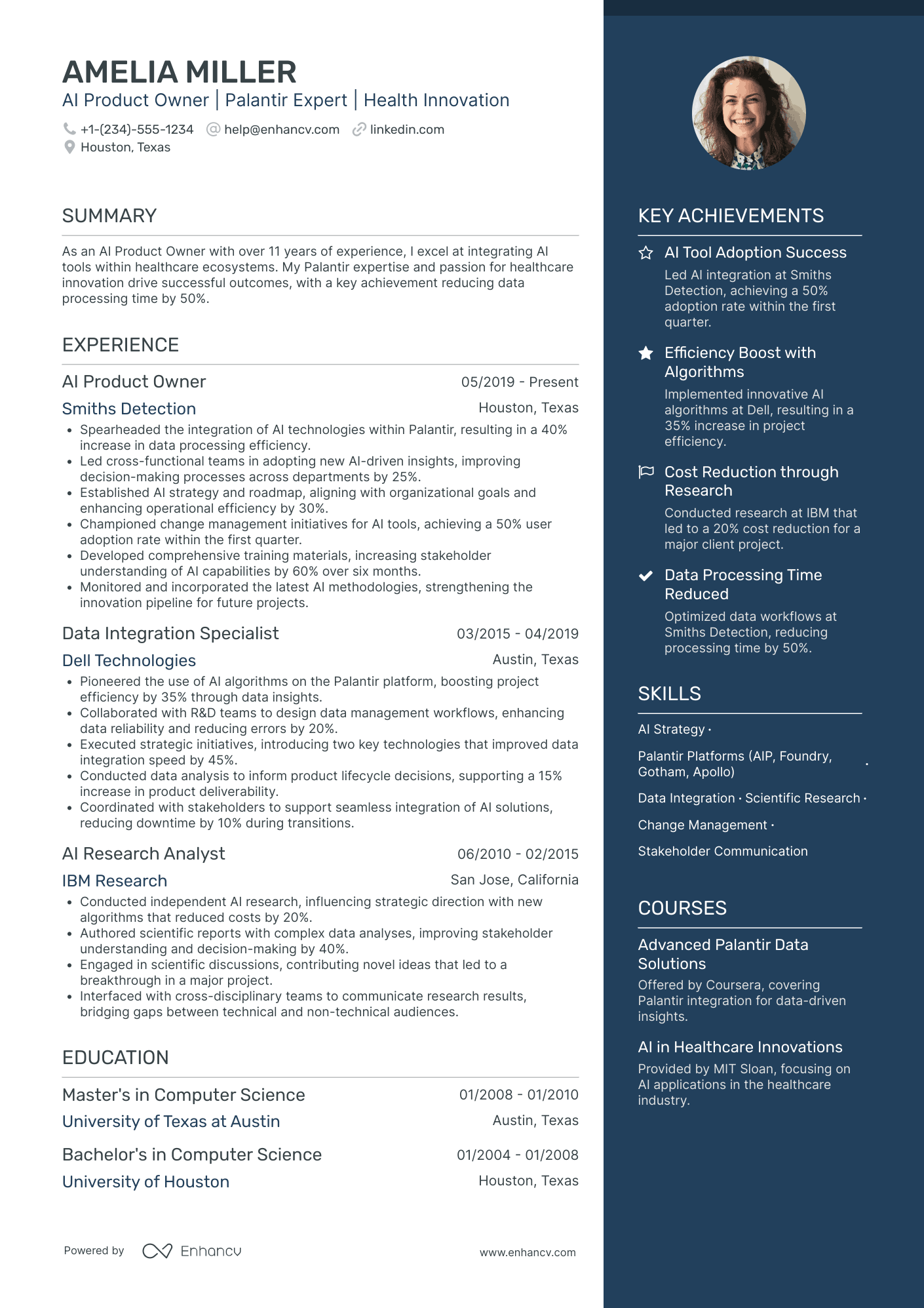Product owners face a significant challenge when it comes time to update their resumes. They need to demonstrate their relevant experience and skills in a way that clearly portrays them as results-driven product owners who have a strong track record for selling a product or service.
This product owner resume guide focuses on the common mistakes and pitfalls that many product owners struggle with when updating their resumes, like not quantifying the successes of past product launches, showcasing agile/SCRUM methodologies, or the effect product updates have on their customers.
In this guide, we’ll show you how to impress recruiters and hiring managers by properly:
- Demonstrating comprehensive knowledge of Agile and Scrum methodologies in a way that highlights the success of product launches from start to finish.
- Balancing a mix of technical, business, and personal skills in a way that equally reflects all of your relevant skills.
- Showcasing leadership abilities within interdepartmental and cross-functional teams while highlighting team or individual achievements.
- Highlighting your successful projects in a way that quantifies metrics like increased efficiency, reduced costs, or raised profitability from the successful roll-out of a product or service.
We use real-world examples from product owner resumes to demonstrate how to create a well-formatted resume. This demonstrates your skills in a way that makes you stand out above the rest.
If this resume guide isn’t in line with your career path, check these ones out for similar roles:
- Product Specialist Resume Guide
- Technical product owner Resume Guide
- Product Designer Resume Guide
- Product Engineer Resume Guide
- Product Analysis Resume Guide
First things first, let’s go over the most common resume formats and which sections you need to include.
How to format a product owner resume
Using the correct format for your resume is essential if you want any chance of interviewing for the position. With the popularity of applicant tracking systems (ATS) on the rise, formatting is more crucial than ever.
Let’s look at the standard setting for your resume. These are the same settings as most word processing applications, like Microsoft Word and Google Docs:
- One-inch margins on all sides.
- Single line spacing with a font size between 10 and 12 points.
- A plain, white background.
When choosing your resume fonts, only use a serif or sans serif font. These are the easiest fonts to read on paper or screen and are available on all operating systems. These include Arial, Times New Roman, and Courier, as well as more modern fonts like Eko 2, Lato, Montserrat, Railway, Rubix, and Volkhov.
Your resume includes five main sections: resume header, personal statement, work experience, education, and a skills section. We’ll go through each of these sections and how to best format them, along with additional resume sections a little later on.
To get a jump start on creating your resume, choose one of Enhancv’s resume templates. You’ll find that there are a number of different layouts and styles to choose from. The one you choose is up to you, but each template has its own unique benefits that you should be aware of:
- Reverse-chronological: This is the most common resume format today and lists your work experience, starting with your most recent job and working backward from there. It presents a clear narrative of your career and emphasizes your past work experience over your skills.
- Functional: This format puts more of a focus on your relevant skills. It is best for those just out of college or who are changing careers and have more skills than real-world product owner experience.
- Combination/Hybrid: With this format, you get the best of both reverse-chronological and functional formats. It allows more experienced product owners to prioritize their skills and work experience in an easy-to-ready formet.
The best format for product owners with an established career and a wide range of technical and business skills is the combination/hybrid format and a two-column layout. This layout allows you to display your skills right alongside your career summary and work experience
No matter which layout you choose, remember to keep your resume to no more than two pages. This is enough space to list all of your qualifications to make an impression.
When you’ve finished your resume and want to submit it, don’t send the original file—save it as a PDF document type (.pdf). All operating systems accept this document type and will retain the format and layout of your resume, no matter what screen size they’re using.
Each market has its own resume standards – a Canadian resume layout may differ, for example.
If you have a resume ready to go and want a free analysis, run it through our resume checker for tips on how to improve it.
Is your resume good enough?
Drop your resume here or choose a file. PDF & DOCX only. Max 2MB file size.
Let’s break down the top sections of your resume and their importance.
The top sections on a product owner resume
- Title and summary: Start off your resume with your job title and correct contact information, social media or projects portfolio link, and a professional statement about your career goals and accomplishments.
- Key skills: Use multiple sections to highlight your hard and soft skills, such as project management and SCRUM frameworks, negotiation skills, conflict-resolution skills, leadership abilities, and other relevant skills.
- Work experience: A concise, detailed account of your product owner work experience that highlights the success of the product, profit increases, and other key metrics.
- Certifications and education: You must include a brief list of your post-secondary education, technical certificates, and any continuing education courses you are taking.
- Relevant projects and accomplishments: Listing past product launch successes and other product ownership accomplishments shows recruiters you have proven experience in designing, producing, and launching relevant products.
When you begin adding information to each section, keep in mind which information recruiters are looking for:
What recruiters want to see on your resume
- Familiarity with agile methodologies: Demonstrate your experience with agile methodologies to show you are familiar with the philosophy and framework for getting quality products to the market.
- Exceptional customer service skills: You’ll want to highlight your customer service skills and interpersonal skills to show them you are capable of working with all types of people calmly and efficiently.
- Proven leadership experience: product owners need outstanding leadership abilities as they must successfully lead teams of diverse employees to meet or exceed product launch deadlines.
- Results-oriented mindset: Recruiters love to see a proven track record of delivering results that maximize the product's value.
- Understanding of user experience and customer needs: A firm understanding of your customers' needs highlights how you value customer feedback and use it to increase the success of the product.
Now that we have a better understanding of each section, let’s start adding your skills, education, and work experience. Let’s start with your professional history as a product owner.
How to write your product owner resume experience
The resume experience section contains relevant work experience as a product owner. You’ll list up to 3 jobs detailing the duties you performed and how you used your knowledge to improve product production times, decrease costs, or exceed product expectations.
For each job entry, you’ll include:
- The job title.
- The company name and location.
- A brief description of the company, product, or services they provide.
- The dates of employment.
- 3-5 detailed bullet points that highlight your achievements.
Be sure to include relevant keywords and technologies that are listed in the job post. This allows you to create a more targeted resume that speaks to the skills and experience the company is searching for.
To give you an idea of how to detail your past work experience, we’ll take a look at a real-world product owner resume experience example.
- •Created user story acceptance criteria to get buy-in from stakeholders.
- •Owned the planning and scheduling of two-week sprints and articulated the product vision to engineering.
- •Managed and re-prioritized the product backlog, resulting in coming under budget.
- •Directed vendor relationships and contracts, including execution and financial payments.
This example represents what most HR teams and hiring managers come across. It includes a brief description of what they did but falls short on making an impression. There is plenty of industry terminology, but zero results of their efforts. What happened with the two-week sprints? How far did they come under budget? What was the result of their contract negotiations?
Someone reading your resume experience should be able to read this and get the answers they need, not be left with more questions. Let’s see if we can update this example and get the answers we need to determine this person’s capabilities.
- •Created user story acceptance criteria to get buy-in from stakeholders and refined those stories with Scrum teams.
- •Owned the planning and scheduling of two-week sprints and articulated the product vision to engineering, resulting in hitting 98% of the product goals defined at the beginning of the year in 2017.
- •Managed and re-prioritized the product backlog, resulting in coming under budget by an average of $45,000 on products.
- •Directed vendor relationship and 30% of contracts, including execution and financial payments, leading to a 28% increase in successful contract negotiations.
After reading this example, what do you think? Does it answer our questions?
Adding additional details can make your past work experience impress recruiters and get you to the top of the interview list. Some of the things this example does a great job of include:
- Describing the product methodologies used.
- Detailing specific product launches and quantifying their results.
- Highlighting cost-saving initiatives with a dollar figure.
- Showcasing necessary soft skills, such as negotiation, interpersonal skills, and leadership abilities.
Did you notice the addition of the company description? Don’t assume the person reading your resume will know what the company you worked for does, even if it’s a well-known organization like Bloomberg. Be thorough and include the company details, as this is something recruiters like to see.
A company that makes children’s toys will have different agile and scrum methodologies than a company that makes weapons, and this information can help determine your qualifications.
In the next section, we’ll use more real-world resume examples to show you which product owner metrics recruiters like to see quantified.
How to quantify the impact on your resume
One of the biggest complaints from recruiters and HR teams about resumes is a lack of detailed information that clearly shows how the person used their skills to take a product or service from a thought to a reality.
Using numbers and percentages is the best way to detail your product owner experience in a way that shows actionable results.
You can make a big impression on recruiters by quantifying the following metrics:
- Value of budgets you’ve managed: “Performed cohort analysis that identified an opportunity to reduce pricing by 18% for a segment of users to increase annual sales by $1.2M.”
- Product performance metrics: “Owned the product roadmap and met 96% of all feature deadlines by proactively identifying and mitigating engineering roadblocks.”
- Market or revenue growth of the product: “Developed 6 different user stories for a new subscription product, leading to focused marketing copy and an ROI increase of 16%.”
- Decreases in production times or costs: “Managed the product backlog and facilitated sprint planning, resulting in a 40% increase in team productivity and a 20% reduction in project delivery times.”
- Increases in customer satisfaction scores or user engagement: “Monitored product performance and tracked key metrics and user feedback, resulting in a 20% increase in customer satisfaction and a 15% increase in user engagement.”
- Improvements caused by the implementation of the product: “Designed a microservices architecture that increased cluster stability by 34%, which tripled the company’s user traffic.”
- Increases in product adoption rates: “Collaborated with product development on market fit analysis for new products, contributing to a 95% product adoption rate within the first year.”
- Reduction in churn rates: “Implemented quantitative analysis techniques to improve the website user experience for 100,000+ clients, contributing to a 25% decrease in customer turnover rates.”
Now, we’ll turn our attention to those who are looking to land their first product owner job.
How do I write a product owner resume with no experience
Having no experience as a product owner does not mean you can’t qualify for an entry-level position. This is a highly skilled position that requires several years of experience working in relatable jobs that also require 2-3 years of experience to qualify. The typical job titles that recruiters see from first-time product owners include:
- Project managers
- Business analysts
- Software developers
- Marketing managers
- Business operators
When choosing which jobs to include on your resume, focus on those jobs where you gained experience in using agile and scrum methodologies, analyzing product development or performance data, and developing updates to existing products or services.
Be sure to include details about any team accomplishments and your experience with conflict resolution, attention to detail, organizational and time management skills, and other necessary soft skills.
First-time product owners should emphasize their memberships in professional organizations to highlight their connection to the industry. The Enhancv professional association section allows you to list any memberships to the Product Development and Management Association (PDMA), Project Management Institute (PMI), or other affiliations.
Now that you’ve added your work experience, let’s work on those sections where you’ll detail your technical and interpersonal skills.
How to list your hard and soft skills on your resume
You can only list so many skills in each section before they become too long and cumbersome. To make your resume more legible, you can list additional skills in smaller sections.
In these sections, you’ll include your technical, business, and personal skills to demonstrate a well-rounded background. Adding these skills allows recruiters to get a better picture your your ability to better understand your customer needs and the best strategies to improve and promote the product or service.
Hard skills are learned skills that you pick up in school, internships, technical training, and practical work experience. They include skills like using agile and scrum methodologies to design, implement, and produce a product or service, digital marketing strategies, business analysis, risk assessments, UI design, and other technical and business skills.
Enhancv’s technical skills section allows you to group your technical skills so you can display more of your essential skills, like so.
Here are the most in-demand product owner hard skills.
Best hard skills for your product owner resume
- Agile methodologies
- SCRUM framework
- Product life cycle management
- JIRA
- Stakeholder management
- SQL
- Budgeting
- Project management
- Python
- Backlog management
- Data analysis
- Product development
- Digital marketing strategies
- Business analysis
- Tableau
- Java
- Risk assessment
- ROI calculations
- Business case development
- User interface design
Soft skills are those skills that you pick up through everyday interactions with your family, friends, peers, teachers, and mentors. They include skills like emotional intelligence, communication skills, and the ability to express empathy and compassion.
These skills allow product owners to be more effective leaders who can work with all levels of employees and come up with creative solutions to inspire team members.
These are the typical soft skills that experienced product owners possess to succeed.
Best soft skills for your product owner resume
- Leadership
- Time management
- Communication
- Decision making
- Negotiations
- Problem-solving
- Adaptability
- Teamwork
- Creativity
- Emotional intelligence
- Attention to detail
- Conflict resolution
- Presentation skills
- Initiative
- Facilitation
- Customer service
- Empathy
- Patience
- Active listening
- Critical thinking
Enhancv has multiple sections where you can add your soft skills and fits nicely into a two-column layout.
In the next section, we’ll go over adding your education and technical training.
How to list your certifications and education on your resume
The education section allows you to highlight your post-secondary education and any continuing education courses. If you have any technical certifications, you’ll include those in a separate section, which we’ll talk about next.
When listing your education, you will do so in reverse chronological order, starting with your most recent education. Each entry will need to include:
- Degree type and name.
- School name and location.
- Attendance/graduation date.
- 3-5 bullet points detailing related courses and any academic accomplishments.
- •Business ethics
- •Business strategy
- •Data analytics
- •Leadership and management
You only need to include your coursework if you have less than five years of product ownership experience or if it directly relates to the position and you don’t have that specific experience.
While most companies expect their product owners to have a bachelor’s and/or master’s degree at a minimum, they also like to see more advanced training in specialized areas.
You only need to include the came of the certificate and the company name who provided the training. You don’t need to include any expiration date, if applicable.
Here are some top certifications that can increase your knowledge and potential earnings and impress recruiters.
Best certifications for your product owner resume
Now it’s time to work on your professional statement, which will be your first chance to impress whoever is reading your resume.
How to write your product owner resume summary or objective
The first thing recruiters will read is your resume summary or objective. This section goes underneath the header and will briefly describe your past work experience and any achievements or plans for meeting career goals. So which one should you write?
A resume summary is for experienced product owners with more than 5 years of real-world experience. It is a career summarization that includes any career highlights and crucial industry metrics, like increasing ROIs, product performance rates, or customer satisfaction increases.
A resume objective is for candidates right out of college or with only a few years of experience. They list their career goals for becoming a product owner and any relatable experience they have, such as working on a team to develop a new product or service or analyzing product performance data.
Let’s use a real-world product owner resume summary example to illustrate what to include in this section.
A resume summary is a brief summary of your skills and experience and you only have 3-5 sentences to make an impression. That means you need to make every line speak to your skills.
The above example does a mediocre job of informing the reader of their potential. It gives a limited picture of their abilities and doesn‘t go far enough to highlight any achievements. Plus, the use of “I am” is unnecessary. You can make more of an impression by starting each sentence with an action verb.
Now, we have an impressive product owner resume summary that clearly shows their abilities and the kind of impact they had on previous product launches. It does an excellent job of:
- Clarifying the number of years of experience.
- Demonstrates interpersonal and leadership skills.
- Uses percentages to quantify key product owner metrics.
- Highlights analysis skills and how they consider customer feedback in their product development.
There are just a few more resume sections that we need to talk about before calling your resume complete.
Additional sections for a product owner resume
Now that we’ve covered all of the required resume sections, let’s look at a few more ways that you can include more of your relevant skills. These next few sections are designed to round out your experience and show relevant information that may make a deeper impact on the reader.
When deciding on which sections to include on your resume, only use those sections that promote your relevant skills. Consider adding some of these additional resume sections:
- Languages: Use this section to highlight your language proficiencies.
- Volunteer experience: This section allows product owners with minimal professional experience to highlight any work where you helped an organization improve its customer charity donation app or adopt product improvements that increase profits.
- Speaking engagements: You can highlight your expertise in product ownership if you led a workshop or were invited to speak at a conference or seminar.
- Awards and recognitions: This is another section where you can include any local or national awards or recognitions from professors and past employers.
Another often overlooked section is the resume header. Beyond including your current contact information and job title that includes any certification standings, you can include a link to a product portfolio on your resume.
Project portfolios allow you to showcase product case studies, roadmaps, metrics and performance data, before and after scenarios, agile and scrum methodologies, press releases, awards, and recognitions.
You can also add a link to a professional social media account, like LinkedIn where you can include a portfolio link and more information about your career and involvement in the community.
Before you start a new job search, be sure to update your LinkedIn profile so it matches the skills and experience on your resume.
Key takeaways
Throughout the resume guide, we’ve gone over the biggest mistakes product owners make on their resumes and how to fix them. By now, your resume should be properly formatted in a way that clearly:
- Uses your technical, business, and interpersonal skills to paint a picture of a well-rounded product owner with a number of essential skills.
- Quantifies past work experience in a way that demonstrates your ability to bring a product to market and make necessary changes to maximize profits.
- Highlights agile and scrum methodologies that show a clear path from vision to reality to product or service launch.
- Demonstrates successful past product launches by including a portfolio link in the header and on job board profiles.
